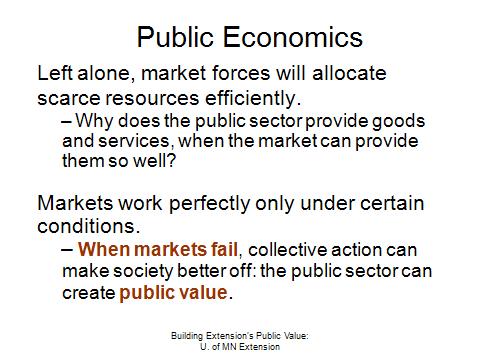I am continuing to look for ways that the theory of transformative learning–including the disorienting dilemma and perspective change that Mezirow (1) included as elements–applies to the “Building Extension’s Public Value ” workshop. One of the ways we try to encourage a perspective change for workshop participants is by setting up the free market ideal…and then knocking it down, or at least identifying its limitations. Hopefully we create a disorienting dilemma for someone who has bought into that free market ideal.
For someone who is confident that there is a private-enterprise-driven, government-hands-off solution to every condition that challenges a community, it’s hard to see a role for publicly-funded outreach programs. But, once that person understands that free markets and private businesses alone can fail to lead to ideal outcomes, she can see that there is room for the public sector to act to improve those outcomes. Outreach programs in general, and Extension programs in particular, are one way the public sector can take action. (Recall that the “Public Value of Public Programs” workshop makes the same kind of case for outreach education that is sponsored by local governments and non-profits.)
I presented this argument, and the above slide, last week when I guest lectured in the “Transforming Public Policy” (PA 8001) course in the Hubert H. Humphrey Institute of Public Affairs, here at the University of Minnesota. A student challenged me by saying that she didn’t see the point of my illustrating the limitations of the free market argument because she didn’t believe it in the first place. She started from the perspective that the public sector has a role in addressing market failure, and so didn’t need to make the transformation I was advancing.
Surely, this is often the case: that the audience for the BEPV workshop (Extension professionals) is made up of people who fully grasp the limitations of the market ideal. That’s why they work for Extension in the first place! But, the above illustration is really intended to help BEPV participants to view the world from the perspective of a stakeholder who is skeptical about public sector involvement in the economy: someone who highly values the role of private enterprise. Hopefully, BEPV participants will then be better positioned to make their case for Extension to that skeptical stakeholder, perhaps by setting up the disorienting dilemma and inducing a perspective change in them.
(1) Mezirow, J. (Ed.). (2000). Learning as transformation: Critical perspectives on a theory in progress. San Francisco: Jossey-Bass.
